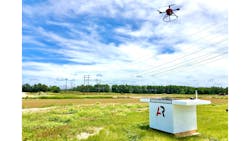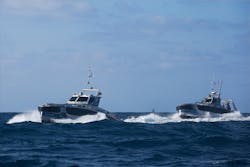American Robotics receives FAA permissions for flights without humans on-site
In this week’s roundup from the Association for Unmanned Vehicle Systems International, which highlights some of the latest news and headlines in unmanned vehicles and robotics, American Robotics becomes the first company to earn FAA approval for drone operations without humans on-site and unmanned surface vehicles prepare for military duty in mine countermeasure missions.
American Robotics receives approval to operate automated drones without human operators on-site
Automated drone systems developer American Robotics has become the first company approved by the FAA to operate automated drones without human operators on-site.
American Robotics is known for its Scout System, which is made up of three primary components: Scout, an autonomous, AI-powered UAS with advanced imaging payloads; ScoutBase, a weatherproof base station that serves as the nerve center and communication hub for Scout; and ScoutView, a secure web portal and API that enables remote interaction with the system, data, and resulting analytics anywhere in the world.
The Scout System also features advanced acoustic Detect-and-Avoid (DAA) technology that enables its drones to maintain a safe distance from other aircraft at all times. The company has developed a layered, redundant system of safety that includes proprietary technical and operational risk mitigations. With this development, American Robotics says that it has proven that its drone-based aerial intelligence platform operates safely in the National Airspace System (NAS), even when it conducts flights beyond-visual-line-of-sight (BVLOS) of the operator.
“With these approvals, American Robotics is ushering in a new era of widespread automated drone operations,” says Reese Mozer, CEO and co-founder of American Robotics.
“Decades worth of promise and projection are finally coming to fruition. We are proud to be the first company to meet the FAA’s comprehensive safety requirements, which had previously restricted the viability of drone use in the commercial sector.”
With this approval, American Robotics’ Scout System is now the first drone technology allowed to continuously operate without this human requirement. Each Scout drone lives within ScoutBase, which enables autonomous charging, data processing and analysis at the edge, and data transmission. Once installed in the field, all facets of Scout’s operation are automated, allowing this technology to gather and analyze ultra-high-resolution data multiple times per day for multiple years without expensive human labor.
During a rigorous four-year testing program, American Robotics demonstrated the impact that its Scout Systems can have on industrial and agricultural industries by engaging with multiple organizations across eight states in the U.S. Last year, Scout Systems flew as many as 10 automated missions per day, capturing a variety of advanced data. Equipped with the real-time analytics derived from this data, farmers, agronomists, industrial operators, security personnel, and maintenance crews can accurately track the health and status of their operations, at a resolution and frequency not previously possible.
According to American Robotics, the Scout System captures and processes data at resolutions, frequencies, and speeds never before feasible. The company adds that Scout provides an “unmatched level” of autonomy, safety, and analytics with its industrial-grade design and advanced, AI-powered software.
Elbit Systems to supply Seagull USVs to the Navy of a country in Asia-Pacific
Elbit Systems has been awarded a contract to supply Seagull USVs to the Navy of a country in Asia-Pacific.
Under the contract, which will be performed over a 17-month period, Elbit Systems will provide Seagull USV systems that are specifically configured to perform Mine Counter Measures (MCM) missions while facilitating the option to add technology modules needed for Anti-Submarine Warfare.
The Seagull USVs will be equipped with Side-Scan and Forward-Looking sonars, Mine Identification and Destruction Remotely Operated Vehicles. They will also be equipped with Elbit Systems’ autonomous suite, Combat Management System and Satellite Communication capability.
With the Seagull USVs, the customer’s Navy will be able to execute end-to-end MCM operations, handling bottom, moored and drifting seamines. The Seagull USV offers endurance of four days, sea-keeping missions of up to Sea-State 5 and the flexibility to control several vessels from the same Mission Control System.
“There is a growing recognition of the essentiality of autonomous capabilities to perform a range of maritime missions, especially Mine Counter Measures and Anti-Submarine Warfare,” says Elad Aharonson, general manager of Elbit Systems ISTAR.
“The Seagull USV has proven, since 2017, its capability to perform such missions, providing Naval forces with increased mission effectiveness, reduced risk and better cost-efficiency.”
Compiled by Brian Sprowl, Associate Editor, AUVSI
Share your vision-related news by contacting Dennis Scimeca, Associate Editor, Vision Systems Design
SUBSCRIBE TO OUR NEWSLETTERS

